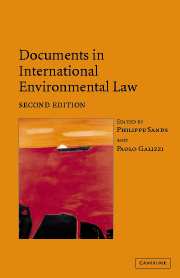Book contents
- Frontmatter
- Contents
- Preface
- PART I General instruments
- PART II Atmosphere
- PART III Oceans: global
- PART IIIB Oceans: regional
- PART IV Freshwater resources
- PART V Biodiversity
- PART VIA Hazardous substances and activities: nuclear
- PART VIB Hazardous substances and activities: pesticides
- PART VIC Hazardous substances and activities: waste
- PART VII Human rights and the environment
- PART VIII War and the environment
- PART IX Trade and the environment
- PART X Environmental impact assessment and access to information
- PART XI Liability for environmental damage and breaches of environmental obligations
- PART XII The Antarctic
- 47 Antarctic Treaty, 1 December 1959
- 47A Protocol on Environmental Protection to the Antarctic Treaty, 4 October 1991
- 48 Convention for the Conservation of Antarctic Seals, 1 June 1972
49 - Convention on the Conservation of Antarctic Marine Living Resources, 20 May 1980
Published online by Cambridge University Press: 05 June 2012
- Frontmatter
- Contents
- Preface
- PART I General instruments
- PART II Atmosphere
- PART III Oceans: global
- PART IIIB Oceans: regional
- PART IV Freshwater resources
- PART V Biodiversity
- PART VIA Hazardous substances and activities: nuclear
- PART VIB Hazardous substances and activities: pesticides
- PART VIC Hazardous substances and activities: waste
- PART VII Human rights and the environment
- PART VIII War and the environment
- PART IX Trade and the environment
- PART X Environmental impact assessment and access to information
- PART XI Liability for environmental damage and breaches of environmental obligations
- PART XII The Antarctic
- 47 Antarctic Treaty, 1 December 1959
- 47A Protocol on Environmental Protection to the Antarctic Treaty, 4 October 1991
- 48 Convention for the Conservation of Antarctic Seals, 1 June 1972
Summary
Editorial note
The Convention on the Conservation of Antarctic Marine Living Resources was concluded to develop and implement conservation measures aimed at protecting Antarctic marine resources from over-harvesting. The following conservation principles must be complied with when engaging in harvesting or other related activities: prevention of decreases in harvested populations to levels below which stable recruitment cannot be ensured; maintenance of ecological relationship with dependent and related species; and prevention of changes to the marine ecosystem which are not reversible over two or three decades (Article II). Parties agree to abide by the principles and purposes of the Antarctic Treaty and comply with the recommendations on environmental protection of the Antarctic Treaty Consultative Parties, regardless of whether they are Parties to that Treaty (Articles III–V).
The Convention establishes the Commission on the Conservation of Antarctic Marine Living Resources composed of representatives of those Parties which participated in the meeting at which the Convention was adopted and of those Parties acceding to the Convention which engage in research or harvesting in relation to marine living resources (Article VII). Each member of the Commission must contribute to its budget, with Members giving equally for the first five years and thereafter contributing proportionally based on the amount of resources harvested (Article XIX). The Commission is to facilitate scientific research; compile, analyse, disseminate and publish information on harvested and dependent species; formulate conservation measures and implement a system of observation and inspection on board ships engaged in harvesting or scientific research (Article IX(1)).
- Type
- Chapter
- Information
- Documents in International Environmental Law , pp. 1365 - 1380Publisher: Cambridge University PressPrint publication year: 2004



